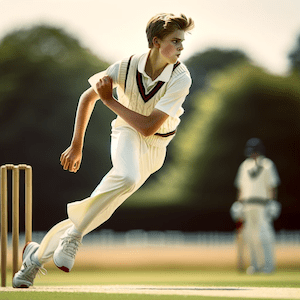Cricket Injuries
Article by John Miller

Cricket Injury Rates
Introduction
Welcome to our informative guide on preventing and managing cricket injuries. At PhysioWorks, we understand the passion Australians have for cricket, and we’re here to ensure you stay fit and injury-free. Whether you’re a budding junior or a seasoned cricketer, this guide offers valuable insights to keep you on the pitch and performing your best.
Understanding Cricket Injuries
Cricket, a sport deeply ingrained in Australian culture, is not without its risks. Common injuries include muscle strains, particularly in the hamstring and side, due to the sport’s demands like sprinting and throwing. Young fast bowlers often face lower back issues, with repetitive bowling motions leading to stress fractures in the lower back vertebrae.
Related Articles:

Cricket Australia’s Junior Bowling Guidelines
Cricket Australia’s guidelines play a critical role in safeguarding our young cricketers. These guidelines, based on extensive research, aim to reduce injury risk, particularly in pace bowlers. Adhering to these can significantly lower the chances of season-ending injuries.
Related Articles:
Injury Prevention Strategies
Preventing injuries is key to a long and enjoyable cricket career. Strategies include maintaining core stability, ensuring proper muscle length-tension ratios, and focusing on technique correction. Tailored exercises and biomechanics analysis can significantly contribute to injury prevention.
In cricket, as in all sports, prevention is better than cure. By understanding the common injuries, adhering to guidelines set by Cricket Australia, and incorporating effective prevention strategies, cricketers can enjoy a healthier, more successful sporting journey. Always remember, your physiotherapist is your best ally in staying fit and injury-free on the cricket field.
Effective injury prevention in cricket involves a combination of proper technique, strength and conditioning, and awareness of the body’s limits. Tailored exercises, biomechanics analysis, and regular consultations with a physiotherapist can significantly reduce the risk of injuries.
- Core Stability and Strength: Essential for maintaining good posture and reducing the strain on the back and limbs.
- Flexibility and Mobility: Regular stretching and mobility exercises can prevent muscle strains and joint injuries.
- Technique Correction: Proper bowling and batting techniques are crucial to avoid overuse injuries. Seek the advice of a qualified cricket coach.
Related Articles:
Common Cricket Injuries and Their Management
Cricket, while a fascinating sport, poses various injury risks. Understanding these injuries is the first step in effective prevention and management.
Back Pain:
A frequent complaint among cricketers, often caused by overuse or poor technique.
Shoulder Pain:
Crucial for bowling and batting, shoulder injuries need careful attention.
Thigh & Hamstring Pain:
Common due to the sport’s running and quick movements.
Knee Pain:
Essential to manage effectively for a cricketer’s mobility.
Shin & Calf Pain:
Often a result of overuse, requiring proper care and recovery.
Ankle Injuries:
Critical for a cricketer’s agility and movement.
Neck Pain:
Can affect performance, particularly in bowlers and batsmen.

Adolescent Cricket Injuries
Young cricketers face unique challenges as their bodies grow and develop. Awareness and proper management of these injuries are vital for their long-term cricketing journey.
Back Pain:
Common in young fast bowlers due to the stress of bowling.
Knee Pain:
Often related to growth spurts and increased activity.
Heel Pain:
Can be particularly troubling for active, growing adolescents.
Conclusion
Cricket is a sport that requires skill, endurance, and physical fitness. By understanding common injuries and implementing effective prevention strategies, cricketers can enjoy a healthier and more successful sporting career. Remember, staying informed and proactive is key to a long and injury-free cricket journey. Consult your physiotherapist for personalised advice and strategies tailored to your needs.



